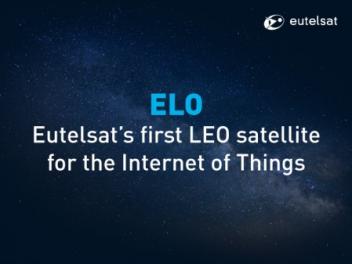Eutelsat Communications (NYSE Euronext Paris: ETL), one of the world’s leading satellite operators, has commissioned a nano-satellite from manufacturer Tyvak International SRL, a subsidiary of Terran Orbital Corporation, a leading aerospace provider of nanosatellite and microsatellite vehicles and services. Eutelsat LEO for Objects (ELO) will be used to assess the performance of low earth orbit (LEO) satellites in providing narrowband connectivity for objects. The satellite operator will be drawing on the technology of Sigfox, which runs a unique global narrowband network dedicated to the IoT.
Low earth orbit is particularly well-suited to narrowband connectivity for objects. It offers a satellite link anywhere in the world, is complementary to terrestrial IoT networks, and does not impact the cost or the energy consumption of the objects. ELO, scheduled for launch in 2019, will backhaul information from objects located in areas that are not served by terrestrial networks and offer redundancy on existing terrestrial network coverage.
Sigfox will work with Eutelsat on two aspects: analyse the spectrum used by the satellite in ISM[1] frequency bands; and process data from objects. ELO will also test connectivity in other frequency bands. The synergies developed through the partnership with Sigfox, as well as with other strategic alliances in the telecom industry, should open up new opportunities for Eutelsat in this fast-growing market.
Jean-Hubert Lenotte, Chief Strategy Officer at Eutelsat, commented: “With the expansion of the Internet of Things, new services are being developed in a wide range of sectors including smart cities, the mining industry, agriculture and logistics. We are delighted to be exploring new avenues through the development of this nano-satellite, which once again demonstrates the intrinsic complementarity between terrestrial networks and satellite technology. By analysing the compatibility of LEO and connected objects, and working with recognised partners in the field, Eutelsat aims to provide an innovative solution which will meet the needs of future clients.”
How does it work?
Located on a sun-synchronous orbit between 500 and 600 km in altitude, the satellite will collect data from connected objects across the globe equipped with the same omni-directional antennas already used by terrestrial IoT networks. Data will then be transmitted daily to a ground station located on Svalbard, a Norwegian archipelago in the Arctic Ocean.
Source: Eutelsat Press Release

